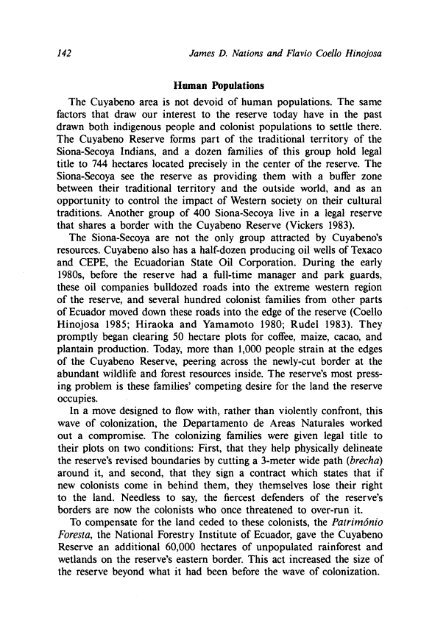Fragile Lands of Latin America Strategies for ... - PART - USAID
Fragile Lands of Latin America Strategies for ... - PART - USAID
Fragile Lands of Latin America Strategies for ... - PART - USAID
You also want an ePaper? Increase the reach of your titles
YUMPU automatically turns print PDFs into web optimized ePapers that Google loves.
James D. Nations and Flavio Coello Hinojosa<br />
Human Populations<br />
The Cuyabeno area is not devoid <strong>of</strong> human populations. The same<br />
factors that draw our interest to the reserve today have in the past<br />
drawn both indigenous people and colonist populations to settle there.<br />
The Cuyabeno Reserve <strong>for</strong>ms part <strong>of</strong> the traditional territory <strong>of</strong> the<br />
Siona-Secoya Indians, and a dozen families <strong>of</strong> this group hold legal<br />
title to 744 hectares located precisely in the center <strong>of</strong> the reserve. The<br />
Siona-Secoya see the reserve as providing them with a buffer zone<br />
between their traditional territory and the outside world, and as an<br />
opportunity to control the impact <strong>of</strong> Western society on their cultural<br />
traditions. Another group <strong>of</strong> 400 Siona-Secoya live in a legal reserve<br />
that shares a border with the Cuyabeno Reserve (Vickers 1983).<br />
The Siona-Secoya are not the only group attracted by Cuyabeno's<br />
resources. Cuyabeno also has a half-dozen producing oil wells <strong>of</strong> Texaco<br />
and CEPE, the Ecuadorian State Oil Corporation. During the early<br />
1980s, be<strong>for</strong>e the reserve had a full-time manager and park guards,<br />
these oil companies bulldozed roads into the extreme western region<br />
<strong>of</strong> the reserve, and several hundred colonist families from other parts<br />
<strong>of</strong> Ecuador moved down these roads into the edge <strong>of</strong> the reserve (Coello<br />
Hinojosa 1985; Hiraoka and Yamamoto 1980; Rude1 1983). They<br />
promptly began clearing 50 hectare plots <strong>for</strong> c<strong>of</strong>fee, maize, cacao, and<br />
plantain production. Today, more than 1,000 people strain at the edges<br />
<strong>of</strong> the Cuyabeno Reserve, peering across the newly-cut border at the<br />
abundant wildlife and <strong>for</strong>est resources inside. The reserve's most press-<br />
ing problem is these families' competing desire <strong>for</strong> the land the reserve<br />
occupies.<br />
In a move designed to flow with, rather than violently confront, this<br />
wave <strong>of</strong> colonization, the Departamento de Areas Naturales worked<br />
out a compromise. The colonizing families were given legal title to<br />
their plots on two conditions: First, that they help physically delineate<br />
the reserve's revised boundaries by cutting a 3-meter wide path (brecha)<br />
around it, and second, that they sign a contract which states that if<br />
new colonists come in behind them, they themselves lose their right<br />
to the land. Needless to say, the fiercest defenders <strong>of</strong> the reserve's<br />
borders are now the colonists who once threatened to over-run it.<br />
To compensate <strong>for</strong> the land ceded to these colonists, the Patrim6nio<br />
Foresta, the National Forestry Institute <strong>of</strong> Ecuador, gave the Cuyabeno<br />
Reserve an additional 60,000 hectares <strong>of</strong> unpopulated rain<strong>for</strong>est and<br />
wetlands on the reserve's eastern border. This act increased the size <strong>of</strong><br />
the reserve beyond what it had been be<strong>for</strong>e the wave <strong>of</strong> colonization.

















